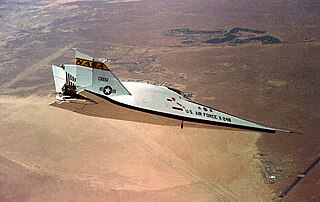
The Martin Marietta X-24 was an American experimental aircraft developed from a joint United States Air Force-NASA program named PILOT (1963–1975). It was designed and built to test lifting body concepts, experimenting with the concept of unpowered reentry and landing, later used by the Space Shuttle. Originally built as the X-24A, the aircraft was later rebuilt as the X-24B.
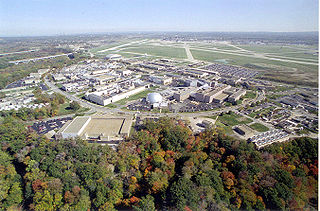
NASA John H. Glenn Research Center at Lewis Field is a NASA center within the cities of Brook Park and Cleveland between Cleveland Hopkins International Airport and the Rocky River Reservation of Cleveland Metroparks, with a subsidiary facility in Sandusky, Ohio. Its director is Marla E. Pérez-Davis. Glenn Research Center is one of ten major NASA facilities, whose primary mission is to develop science and technology for use in aeronautics and space. As of May 2012, it employed about 1,650 civil servants and 1,850 support contractors on or near its site.
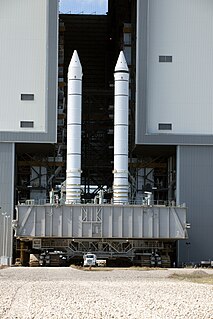
The Space Shuttle Solid Rocket Booster was the first solid-propellant rocket to be used for primary propulsion on a vehicle used for human spaceflight and provided the majority of the Space Shuttle's thrust during the first two minutes of flight. After burnout, they were jettisoned and parachuted into the Atlantic Ocean where they were recovered, examined, refurbished, and reused.

The John C. Stennis Space Center (SSC) is a NASA rocket testing facility in Hancock County, Mississippi, on the banks of the Pearl River at the Mississippi–Louisiana border. As of 2012, it is NASA's largest rocket engine test facility. There are over 50 local, state, national, international, private, and public companies and agencies using SSC for their rocket testing facilities.
In physics and materials science, a drop tower or drop tube is a structure used to produce a controlled period of weightlessness for an object under study. Air bags, polystyrene pellets, and magnetic or mechanical brakes are sometimes used to arrest the fall of the experimental payload. In other cases, high-speed impact with a substrate at the bottom of the tower is an intentional part of the experimental protocol.

A space toilet or zero gravity toilet is a toilet that can be used in a weightless environment. In the absence of weight, the collection and retention of liquid and solid waste is directed by use of airflow. Since the air used to direct the waste is returned to the cabin, it is filtered beforehand to control odour and cleanse bacteria. In older systems, wastewater is vented into space, and any solids are compressed and stored for removal upon landing. More modern systems expose solid waste to vacuum pressures to kill bacteria, which prevents odor problems and kills pathogens.

Space Power Facility (SPF) is a NASA facility used to test spaceflight hardware under simulated launch and spaceflight conditions. The SPF is part of NASA's Plum Brook Station, which in turn is part of the Glenn Research Center. The Plum Brook Station and the SPF are located near Sandusky, Ohio.

A rocket engine test facility is a location where rocket engines may be tested on the ground, under controlled conditions. A ground test program is generally required before the engine is certified for flight. Ground testing is very inexpensive in comparison to the cost of risking an entire mission or the lives of a flight crew.

Rocket Engine Test Facility was the name of a facility at the NASA Glenn Research Center, formerly known as the Lewis Research Center, in Ohio. The purpose of the Rocket Engine Test Facility was to test full-scale liquid hydrogen rockets at thrust chamber pressures of up to 2100 psia and thrust levels to at least 20,000 pounds. Work on the design of the facility began in 1954 under the auspices of NACA's Rocket Branch of the Fuels and Combustion Research Division. It was built at a cost of $2.5 million and completed in 1957. The facility was located at the south end of the Center, adjacent to Abrams Creek 41.404°N 81.868°W. It was demolished in 2003 in order to make way for the runway expansion of the Cleveland Hopkins International Airport.

The Neutral Buoyancy Simulator was a neutral buoyancy pool located at NASA's George C. Marshall Space Flight Center (MSFC). Engineers and astronauts developed hardware and practiced procedures in this tank from its completion in 1968 through its decommissioning in 1997. Marshall recognized the need for underwater simulations of extra-vehicular activities (EVAs) and developed three successively larger tanks for the purpose. The Neutral Buoyancy Simulator contributed significantly to the American crewed space program. Skylab, the Space Shuttle, Hubble Space Telescope, and the International Space Station have all benefited from the Neutral Buoyancy Simulator. Until Johnson Space Center constructed the Weightless Environment Test Facility in the mid-1970s, MSFC had the only NASA-owned test facility that allowed engineers and astronauts to become familiar with the dynamics of body motion under weightless conditions.

The Lunar Landing Research Facility was an area at NASA's Langley Research Center in Hampton, Virginia that was used to simulate Apollo Moon landings with a mock Lunar Module powered by a small rocket motor suspended from a crane over a simulated lunar landscape.

The Propulsion and Structural Test Facility, also known as Building 4572 and the Static Test Stand, is a rocket testing facility of the George C. Marshall Space Flight Center in Huntsville, Alabama. Built in 1957, it was the site where the first single-stage rockets with multiple engines were tested. It was declared a National Historic Landmark in 1985 for its role in the development of the United States space program.

The Redstone Test Stand or Interim Test Stand was used to develop and test fire the Redstone missile, Jupiter-C sounding rocket, Juno I launch vehicle and Mercury-Redstone launch vehicle. It was declared an Alabama Historic Civil Engineering Landmark in 1979 and a National Historic Landmark in 1985. It is located at NASA's George C. Marshall Space Flight Center (MSFC) in Huntsville, Alabama on the Redstone Arsenal, designated Building 4665. The Redstone missile was the first missile to detonate a nuclear weapon. Jupiter-C launched to test components for the Jupiter missile. Juno I put the first American satellite Explorer 1 into orbit. Mercury Redstone carried the first American astronaut Alan Shepard into space. The Redstone earned the name "Old Reliable" because of this facility and the improvements it made possible.
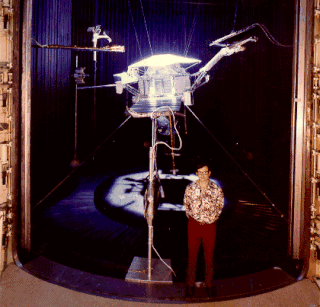
The Twenty-Five-Foot Space Simulator is a chamber designed for testing spacecraft in space-like conditions, including extreme cold, high radiation, and near-vacuum pressure. Built in 1961, it is located at the Jet Propulsion Laboratory in Pasadena, California, and has been used to prepare a large number of American space probes prior to their launches. It was declared a National Historic Landmark in 1985 and is on the National Register of Historic Places.

The Spacecraft Propulsion Research Facility, now known as the In-Space Propulsion Facility, is, the "world’s only facility capable of testing full-scale upper-stage launch vehicles and rocket engines under simulated high-altitude conditions." The facility, located at NASA's Plum Brook Station of the Glenn Research Center near Sandusky, Ohio, was built in 1968. Its first major use was for testing stages of the Centaur Rocket, which was used to launch some of America's most important space probes. The facility was designated a National Historic Landmark in 1985.

The Spacecraft Magnetic Test Facility, also known historically as the Attitude Control Test Facility, is an experimental spacecraft test facility at the Goddard Space Flight Center in Greenbelt, Maryland, United States. It was built in 1966 to allow the evaluation of magnetic movement in manned and unmanned spacecraft, and for the precision calibration of magnetometers used in space flight. The building is constructed of non-magnetic materials and contains a magnetic coil system that allows the cancellation of the Earth's magnetic field. This unique building was designated a National Historic Landmark in 1985.

The Space Environment Simulation Laboratory (SESL) is a facility in Building 32 at the Lyndon B. Johnson Space Center that can perform large-scale simulations of the vacuum and thermal environments that would be encountered in space. Built in 1965, it was initially used to test Apollo Program spacecraft and equipment in a space environment, and continues to be used by NASA for testing equipment. It was designated a National Historic Landmark in 1985.

Weightlessness is the complete or near-complete absence of the sensation of weight. This is also termed zero-G, although the more correct term is "zero G-force". It occurs in the absence of any contact forces upon objects including the human body.
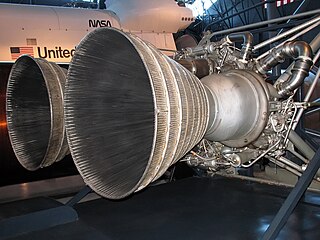
The LR87 was an American liquid-propellant rocket engine, which was used on the first stages of Titan intercontinental ballistic missiles and launch vehicles. Composed of twin motors with separate combustion chambers and turbopump machinery, it is considered a single unit. The LR87 first flew in 1959.
Fastrac was a turbo pump-fed, liquid rocket engine. The engine was designed by NASA as part of the low cost X-34 Reusable Launch Vehicle (RLV) and as part of the Low Cost Booster Technology project. This engine was later known as the MC-1 engine when it was merged into the X-34 project.






















